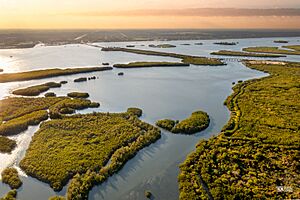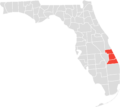Treasure Coast facts for kids
The Treasure Coast is a cool region located in the southeast part of Florida. It's right next to the Atlantic Ocean and includes three counties: Indian River, Martin, and St. Lucie.
The name "Treasure Coast" comes from an exciting event! Back in 1715, a Spanish Treasure Fleet carrying lots of gold and silver was lost in a big hurricane near this coast. Over time, people living here wanted a special name to set their area apart from the "Gold Coast" to the south, which includes places like Palm Beach and Miami.
This area is also part of two important statistical zones called metropolitan areas. These are used by the government to understand population and growth.
Contents
Discovering the Treasure Coast's Past
People have lived in the Treasure Coast area for a very long time. But it wasn't until the 20th century, when more and more people started moving here, that the area got its unique identity. Florida has many "coast" regions, like the Gold Coast and the First Coast.
The name "Treasure Coast" was created by two newspaper guys, John J. Schumann Jr. and Harry J. Schultz. They worked for the Vero Beach Press Journal newspaper. This happened shortly after people started finding Spanish treasure off the coast in 1961.
Finding treasure from the 1715 fleet, which sank near the Sebastian Inlet, was a huge deal! It brought a lot of attention to the area from all over the world. Schumann and Schultz realized their region didn't have a name, especially since it was between the famous Gold Coast to the south and the Space Coast to the north. So, they started calling it the "Treasure Coast" in their newspaper, and the name quickly caught on with everyone.
Exploring the Treasure Coast's Geography
The entire Treasure Coast is protected from the strong Atlantic Ocean waves by narrow strips of sand and barrier islands. These islands create calm, shallow waters like lagoons, rivers, and bays. Just a little bit inland, you'll find many flatlands with pine trees and palmetto plants.
Many lakes and rivers flow through the Treasure Coast. The most famous is the Indian River, which is part of the larger Indian River Lagoon system. Sometimes, certain bridges can block the flow of red algae, which might cause a "rotten egg" smell from something called hydrogen sulfide. The Treasure Coast is also next to the Atlantic part of the Intracoastal Waterway. This is a protected water route that stretches all the way from Texas to Massachusetts!
Communities of the Treasure Coast
Many people on the Treasure Coast live in places called "census-designated places" (CDPs). Most of these are in Martin and Indian River counties. Only one city in the Treasure Coast has more than 100,000 people, and that's Port St. Lucie.
Here are some of the main communities in the Treasure Coast:
Big Cities (More than 100,000 people)
- Port St. Lucie (This is the main city) pop. 217,523
Medium Cities (10,000 to 50,000 people)
- Fort Pierce pop. 43,601
- Sebastian pop. 23,344
- Stuart pop. 16,197
- Vero Beach pop. 16,017
Smaller Towns and Villages (5,000 to 10,000 people)
- Fellsmere pop. 5,439
- Indiantown pop. 6,082
Other Notable Places
- Palm City pop. 23,120
- Vero Beach South pop. 23,092
- Jensen Beach pop. 11,707
- Hobe Sound pop. 11,521
Getting Around the Treasure Coast
Airports
The Vero Beach Regional Airport offers flights with Breeze Airways. If you need more flight options, you can go to Melbourne Orlando International Airport to the north or Palm Beach International Airport to the south. There are also smaller local airports like Treasure Coast International Airport in Fort Pierce and Witham Field in Stuart.
Boats and Waterways
The Port of Fort Pierce is one of Florida's 14 deepwater ports. It's important for bringing in and sending out goods. The Intracoastal Waterway also runs through the Treasure Coast, following the Indian River. The Okeechobee Waterway connects Stuart on the east coast to Fort Myers on the west coast, going through Lake Okeechobee.
Highways
Even though many people live here, the Treasure Coast only has two main north-south highways: Florida's Turnpike (which is a toll road) and Interstate 95. These roads often run parallel to each other. North of Fort Pierce, the Turnpike heads towards Orlando, leaving I-95 as the main north-south highway.
Closer to the coast, U.S. 1 is the main road that goes through the cities. And along the beautiful barrier islands like Hutchinson Island and Orchid Island, you'll find Florida State Road A1A.
Railroads
The Florida East Coast Railway (FEC) runs freight trains along the coast. They also have a rail yard in Fort Pierce.
For a long time, passenger trains used to run along these tracks. But that stopped in 1963. Now, there's exciting news! Brightline, a modern inter-city rail service that connects Miami and Orlando, is planning to build a new station on the Treasure Coast. They announced on March 4, 2024, that the new station will be in Stuart and should start service by 2026!
Images for kids




